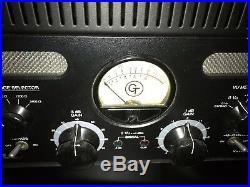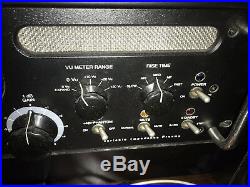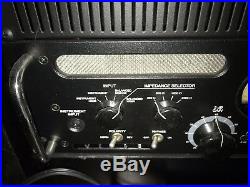Groove Tubes GT Vipre Microphone Mic Tube Preamp Preamplifier BEAST




Recently retubed and has not had much use since then. (Does NOT include original box or manual). This is an imposing beast, measuring nearly 15 inches deep and occupying 3U of rack space, plus a further 1U for the pretty essential included rack reinforcement kit. Since the Vipre weighs 12kg (28lbs), unless you are able to sit it at the bottom of the rack it really needs extra reinforcement to help support the weight. The kit comprises a pair of heavy steel rack ears which are designed to bolt to the rack above the Vipre (occupying 1U of space) and which reach down each side at a 45-degree angle where they screw to the case half way back on either side. The 1U of'dead' rack space above the machine also helps considerably with ventilation, although there is a pair of fine mesh vent grilles at the top of the front panel too.
All the controls are switches none of those newfangled potentiometers here! Five huge silver toggle switches sit next to six big stiff rotary phenolic knobs which operate ceramic switches with satisfyingly loud mechanical clicks.
The entire panel is black with clear white legends and a handful of coloured lamps for the more significant switches and operating conditions. A classic backlit round VU meter takes centre stage.
The basic structure of the preamp is simple enough: there are three inputs (for mic, line and instrument) with a switchable transformer on the mic input and a dedicated valve input stage for the DI. This is followed by an input selector to the main valve preamp stage with coarse and fine gain controls and a few other bits and bobs that I'll come back to later. This amplifier then feeds a valve output driver complete with transformer and metering.The tech specs are very impressive, with a bandwidth of 4Hz to 100kHz (-1.5dB limits) via the mic and line inputs, and 20Hz to 100kHz via the DI input. The equivalent input noise (EIN) is -129dBu (600 source, A-weighted) and up to 75dB of gain is available for mic inputs via the transformer (44dB for line inputs and up to 46dB for DI inputs). The mic input can accommodate up to +14dBm and the line input a massive +30dBm!
All Rise: User-adjustable Transient Response. Perhaps the most interesting aspect of the Vipre is its Rise Time control. This isn't some quirky power-up routine, but a reference to the way in which the amplifier handles transient signals.
When a transient sound wave arrives at a microphone, a transient output voltage will be generated, and that has to be amplified as it passes through the preamp circuitry. However, a voltage cannot change from, say, zero to 2V instantaneously it takes a finite time for the circuitry to increase the voltage and this is known as the slew rate, measured in Volts per microsecond. Modern solid-state amplifier circuits can respond incredibly quickly it's one of the reasons why modern amplifiers sound so much faster and crisper than vintage designs (love'em or hate'em).Indeed, most of the classic equipment from the'50s and'60s had characteristically slow slew rates, producing a softer sound which we tend now to call vintage. As far as I know, the Vipre is unique in that it allows the user easily to adjust the slew rate of its internal amplifiers, thereby changing the unit's sound character in a subtle but very effective manner. A rotary switch provides a range of slew rates from 0.75V/µs (slow) to 6V/µs (fast), with three intermediate positions.
I found the effect of the Rise Time control to be most obvious with transient-rich sources (as you might expect), such as acoustic piano and some percussion. Strangely, I found I could also hear the difference quite clearly on voices too, where the slow setting seemed to lend a more laid-back, mellow character compared to the fastest setting. Looking at the structure of the machine a little more closely, the XLR mic input is provided with switchable phantom power and associated green indicator. It can be routed either via a custom transformer (with selectable impedance matching via one of the large rotary controls), or directly into the balanced valve input amplifier (referred to as the'bridging input'). A line input (via a TRS jack socket) is effectively wired in parallel either the mic or line input can be used, but not both together and there is no mic/line selector as such.The line input is attenuated by a 20dB pad and cannot be routed via the transformer it goes direct to the valve amplifier bridging input. There is a dedicated front-panel unbalanced DI input with its own valve buffer circuit that generates a balanced signal which is then routable to the bridged input amplifier circuit again, either directly or via a 20dB pad. The input selection is controlled by a second large rotary knob with four positions. The bridged input amplifier is a differential gain stage in a Class-A topology based around two pairs of twin-triode 6922 (6DJ8 or ECC88) valves.
Its input impedance (for line inputs) is 24k and within the valve preamp stage are facilities to reverse signal polarity and introduce a high-pass filter (4dB/octave below 100Hz), both via toggle switches. The gain is adjusted by two more rotary switches, a coarse setting in 5dB steps, and a fine one in 1dB steps. Up to 75dB of gain is available for the mic input. There is another very unusual facility here: a five-position Rise Time control alters the circuitry's slew rate for details of how this works, see the'All Rise' box.The DI input employs a 6205 valve (a single triode similar to the EF734) to offer a 470k input impedance for guitar pickups. The circuit is arranged to provide a phase-split balanced output which is routed to the input selector as already described. The output stage again a Class-A topology involves a single 12AT7 (ECC81) driving a matched pair of 6005s (6AQ5) which output into a special transformer complete with a feedback winding to ensure linearity. There are two further secondary windings, one intended for balanced +4dBu outputs (via paralleled XLR and TRS jack sockets) with a 600 source impedance.
The second provides a -10dBV balanced output on another TRS socket, with an unusually high 10k source impedance. The maximum output level from the Vipre is +30dBm from the XLR outputs, which is way above the normal capabilities of a normal -20dB to +3dB VU meter. To avoid having the needle wrapped around the end stop all the time the meter is provided with another rotary selector. The Normal mode displays a conventional range, where 0VU is +4dBm.
In other words, the meter spans the range -16 to +7dBm. The reference to dBm rather than dBu is valid here, as the output impedance is 600, but the actual output signal voltage is the same as the more familiar dBu reference. An expanded range triples the scale readings to allow the meter to span -60dB to +9dB, centred on the same 0VU reference. Three further options shift the reference point for the normal VU mode and set 0VU to equate with +10, +20, or +30dBm. The meter therefore spans the ranges -10 to +13dBm, 0 to +23dBm, or +10 to +33dBm respectively.
However, since we are talking VU meters here, anything loud but transient is unlikely to register its true peak level anyway. Fortunately, Groove Tubes have thought of that and have added a couple of LED peak indicators, a green one set to illuminate 3dB prior to clipping and a red one set to light up when clipping has been reached. The valve amplifier circuits used throughout the Vipre seem to clip very gracefully should you find yourself running out of steam although it takes some doing, I have to say!
Essentially the amplifiers never lose control in the way that some lesser valve circuit designs can do, even when overdriven. Not only are all of the Vipre's rear-panel signal connectors balanced, but also all of its internal preamp circuitry. The Vipre's output transformer is unusually large for a line output device, so it really comes as no surprise that the machine can generate outputs of +30dBm without strain. At this sort of output level, though, any clicks and pops caused by changing settings could destroy following equipment, so Groove Tubes have provided a mute switch which kills all the outputs through a sealed relay, complete with yellow indicator lamp adjacent to the chunky toggle switch. The switch is very handy, but the handbook recommends a simple procedure to minimise the risk of pops and bangs, which is to exercise all the controls from one extreme to the other of their settings immediately after powering the unit up (and with the mute switch engaged). Finally, a Standby switch (with a red light) is provided in conjunction with the main power switch (with a blue light). The idea is that the unit should be powered up initially in standby mode to allow the heaters to reach their working temperature. After about thirty seconds or so the switch can be moved to the normal position (labelled B+ On) which applies the anode HT voltages to the valves for normal operation. This technique is widely used in valve equipment and extends the life of the tubes by avoiding the cold cathode stripping that would otherwise occur. The standby switch can also be used to conserve energy the machine consumes a massive 90 Watts when fully running! , and avoids having to wait for the whole thing to warm up from cold if you want to turn it off for short periods.I found the Vipre to be every bit as impressive as its looks (and price) suggest. It sounds big, smooth, quiet, classic, vintage, rich, warm...
Well you know all the standard adjectives for valve amps, don't you. This shouts them all loud and clear this is definitely one of the great valve mic preamps, with stacks of subtle but distinctive character and some interesting features that push it beyond the realms of the usual. The impedance matching has more audible effect than I was expecting, and if you use (or want to use) vintage ribbon mics, this box will certainly let you extract their true potential.The facility also helps to change the character of modern-day mics in a subtle, but often beneficial way. The Rise Time control is another major bonus this really is the icing on the cake, providing a crisp, fast modern presentation, or a mellow, laid-back yesteryear sound quality. I found I used it more than mic EQ during the review period and it was just as effective in most situations.
This excellent feature, on its own, makes the Vipre worthwhile! I fell in love with the Vipre and was sad to have to box it up and send it back. This really is a great sounding preamp, but I fear it is beyond the fiscal or practical reaches of many UK users, including myself. Even disregarding the pecuniary aspect of the unit for a moment, allocating 4U of space for a single-channel mic pre would be a challenge for many, impressive though it looks in the rack. An aspirational product and one I'm very pleased to have experienced and enjoyed. Before the advent of the practical silicon transistor amplifier around 40 years ago, it was custom and practice in the audio industry to use impedance matching when interfacing equipment this was the era of the 600 termination. In the case of microphones and microphone amplifiers, it was important to transfer as much power between source and destination as possible, and that meant matched impedances. Consequently, microphones (generally ribbons and dynamics) were designed typically with 300 output impedance and the mic amplifiers of the day offered 300 input impedances. However, as technology advanced it became fashionable to use voltage coupling, where the amplifier input impedance was at least ten times higher than the source impedance. Consequently, mic amp inputs gradually rose to something like 1.5k or even 3k.The Vipre is very unusual, as it offers the facility to adjust the input impedance to any one of four values from its front-panel control. These input impedance options are designed to suit a wide range of microphones, both modern and vintage, with 300, 600, 1200, and 2400 settings. The last corresponds to most modern mic preamps and the first to the classic designs of the'50s. The obvious question to ask is what difference changing the impedance makes?
The answer is'not much, most of the time', but I found that the simpler the mic, the more it tended to be affected. In general, the audible changes were fairly subtle, but Groove Tubes claim that classic vintage mics like the American RCA 77 work better if matched to their original design spec of 300.
This may very well be the case, but I didn't happen to have one on hand to check. However, rifling through my own mic cupboard proved that the more modern mics seemed to deliver their best when partnered with higher impedance settings, while an old Coles 4038 ribbon did sound a little smoother and perhaps crisper with the 300 setting. Groove Tubes also suggest that using low impedance settings with modern mics can make them sound vintage. I'm not sure I'd go quite that far, but it certainly changed their characteristics in a subtle and not unpleasant way, and this is therefore useful for creating delicate tonal adjustments a more interesting and subtle form of EQ, if you like.The item "Groove Tubes GT Vipre Microphone Mic Tube Preamp Preamplifier BEAST" is in sale since Wednesday, November 28, 2018. This item is in the category "Musical Instruments & Gear\Pro Audio Equipment\Preamps & Channel Strips". The seller is "baybbayb" and is located in Canyon Country, California.
This item can be shipped to United States.
- Brand: Groove Tubes
- Custom Bundle: No
- Non-Domestic Product: No
- Number of Channels: 1
- Model: Vipre
- Modified Item: No
- Type: Microphone Preamp
- Country/Region of Manufacture: United States
